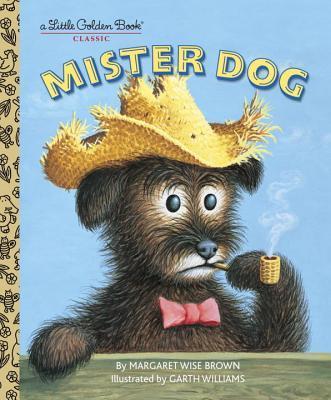Mister Dog, written by Margaret Wise Brown, was first published by Little Golden Books in 1952. This was the last book published in Wise Brown’s lifetime before she died age 42.
Garth Brown illustrated the text in his distinctive Garth Brown style.
The story is about a dog with the stand-out gag that he ‘belongs to himself’. More typically, this personality attribute is given to anthropomorphised cats:
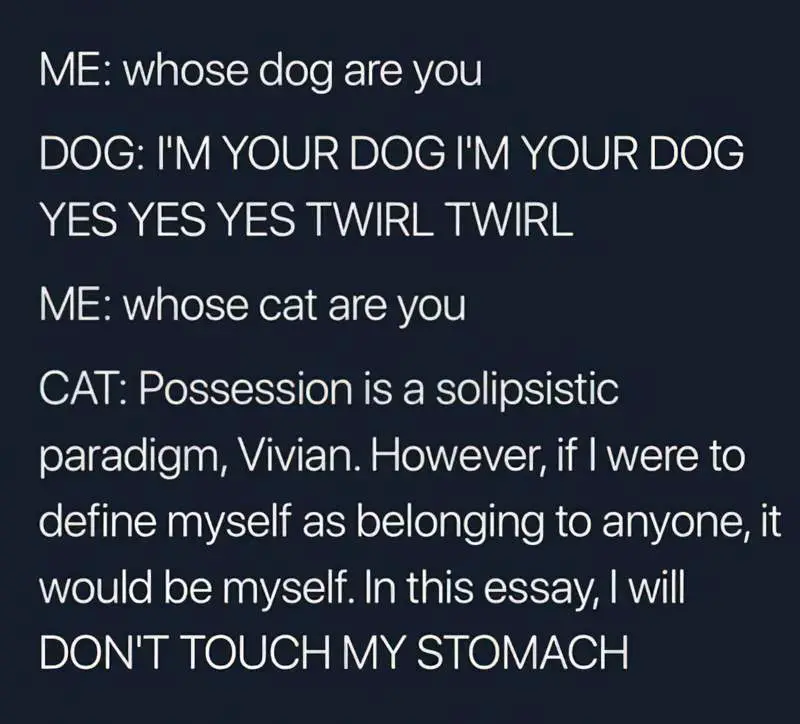
This is reflected in his vaguely recursive (but ultimately nonsensical) name: Crispin’s Crispian*. I believe this was the name of Wise Brown’s own dog, and that the dog ran the show. It makes sense that the author thought of her dog as an individual with his own mind. By all accounts, the author herself refused to be constrained.
*Crispin and Crispian are also meant to be the twin patron saints of certain workmen like cobblers, curriers and tannery workers. I think she probably chose this name because it sounds poetic, not because it makes sense. (Crispin’s Crispin makes sense.)
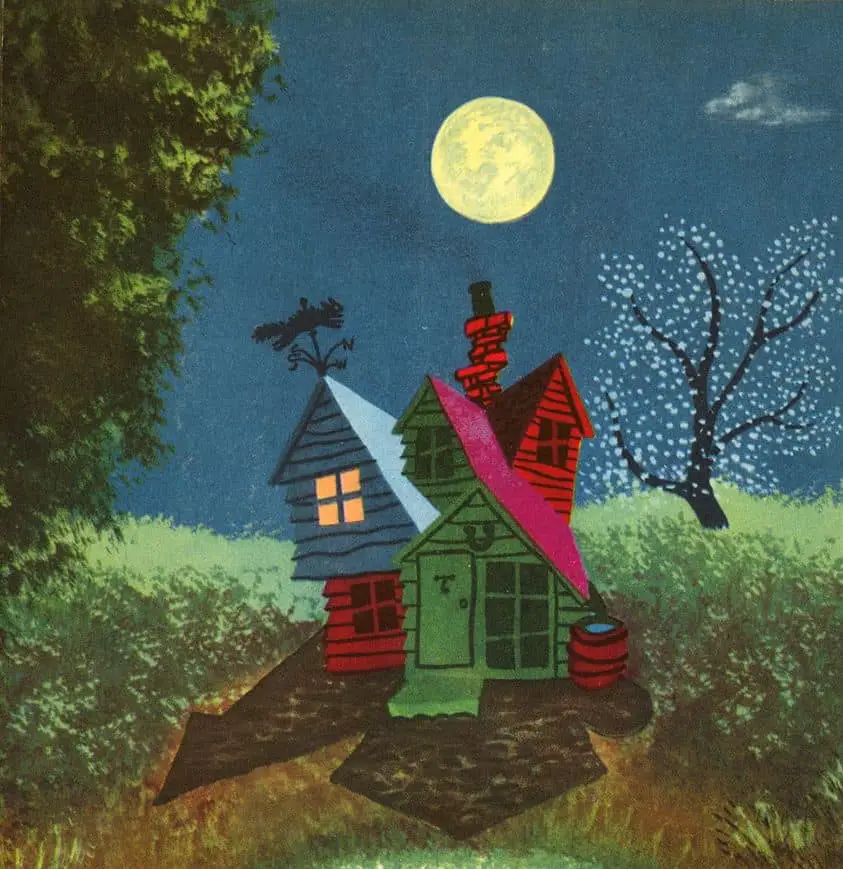
The animals of the world exist for their own reasons. They were not made for humans any more than black people were made for white, or women created for men.
Alice Walker
STORY STRUCTURE OF MISTER DOG
SHORTCOMING
Once upon a time there was a funny dog named Crispin’s Crispian. He was named Crispin’s Crispian because he belonged to himself.
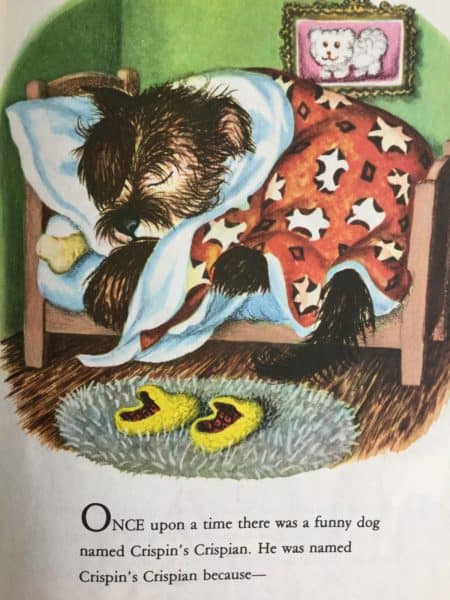
There is no anagnorisis in this story. I have encountered very few stories in which this is the case. A good proportion offer some sort of plot reveal. Another good portion of stories are about characters who fail to learn the lesson they were meant to, and that’s the whole point — people are dumb. But in Mister Dog, none of those atypical anagnorisis things are true.
Mister Dog knows exactly who he is and that’s the point. A character with no Anagnorisis won’t have a psychological shortcoming. Mister Dog doesn’t have a moral shortcoming, either. He is very kind.
As an example of the extent to which Margaret Wise Brown is subverting your more typical dog story for children, here’s another, more contemporary picture book about a dog who doesn’t belong to anyone:
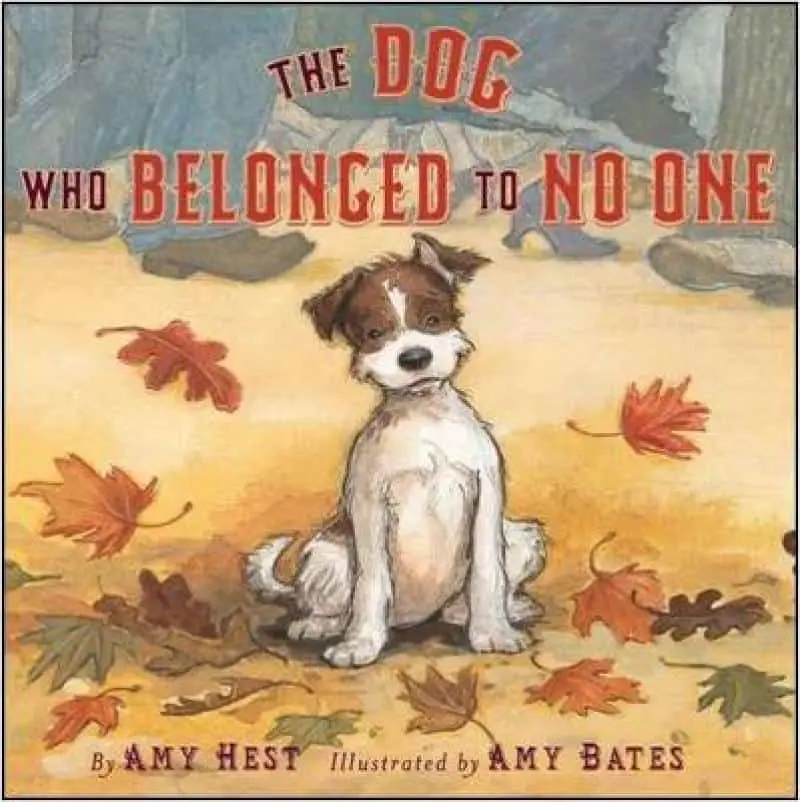
No one takes notice of a small dog with crooked ears who doesn’t have a home. He explores the narrow streets and wide boulevards every day, while across town a little girl named Lia pedals on her bicycle alone, delivering breads and cakes. Both dream of finding a friend, until fate brings them together.
Notice how the marketing copy of this more conventional dog story overtly communicates that ‘fate’ brings dog and human together, as if the world runs on a fatalistic engine in which animals exist as subservient to human animals. This is a persistent ideology which pervades children’s books, which is fine, but Margaret Wise Brown is subverting it. Mostly we chuckle and say of this author, “Wasn’t she quirky”. (To be fair, she was also supremely, wonderfully quirky, including at the moment preceding her death.) But to suggest her work was simply quirky downplays her genius. I’m going to assume that Margaret Wise Brown knew exactly what she was doing. (Perhaps she didn’t, but we assume a detached understanding of self-generated work when talking about other authors, notably white male ones.)
DESIRE
In the mornings, he woke himself up and he went to the icebox and gave himself some bread and milk. He was a funny old dog. He liked strawberries.
This detail tells us that Mister Dog wants to live as a man and to be treated as a man. The accompanying illustration, in which Mister Dog pours milk into his cereal, depicts a middle aged, tired expression rather than the typical happy expression of a dog first thing in the morning. This is a dog who hasn’t had his coffee yet. Humour for the adult audience comes in the form of this irony — that by insisting on the life of a middle aged human, one must bear the burdens that go along with it.
OPPONENT
The cats and the rabbits in the carnivalesque adventure mentioned below function as proxy opponents.
PLAN
In the style of a German fairy tale, Mister Dog has no real plans except to leave the house in the hope that something amazing will happen.
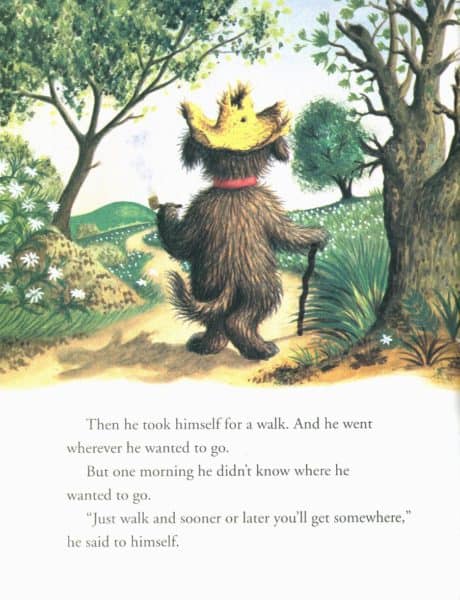
Soon he encounters the field of dogs, where he enjoys a brief carnivalesque moment as a dog again, running around as dogs do. During this sequence he loses his hat. Symbolically, the hat is often ‘the’ thing that separates humans from animals.
Eventually he comes to a little boy and they become firm friends. The little boy seems to be orphaned, so Crispin says, “Come live with me,” which is the new plan. (We get none of the little boy’s back story. In Margaret Wise Brown stories, everything happens easily and, as if, naturally.)
Although we can rightly criticise Little Golden Books for their ridiculous gender imbalance in favour of boys (and the inevitable symbolic annihilation of girls), it’s clear also that the publishers (and writers, and illustrators) really did think they were depicting the ‘every child’ when they made the decision to stick to stories about boys. Sometimes, gender subversion is achieved not by including girls in the story at all (because they’re so often included badly), but by giving male characters stereotypically feminine roles. In Mister Dog, the man prepare the meals, looks after the boy in a caring role and they both keep their house neat and tidy.
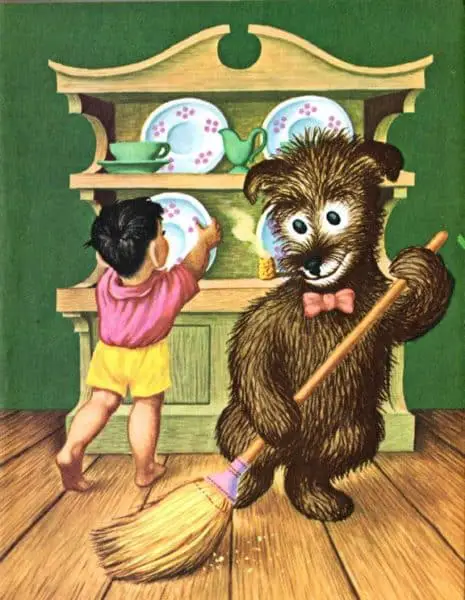
This is something I haven’t looked into in much detail, but instinct tells me stereotypically feminine roles such as the sweeping and arranging of plates above are not depicted much at all in contemporary children’s books. I can’t think of a modern example that encourages young readers to revel in the joy of keeping house in the way that Mister Dog revels in keeping house. Instead, picture book creators have rendered these tasks utterly invisible. This is perhaps an unintended consequence of a lopsided attempt at gender equality. Girl characters can now go out on adventures, but boy characters, conversely, are not staying home to tidy up after themselves and cook.
And if these tasks are rendered invisible, how do children learn to appreciate the person doing them. At what point do they realise that they, too, must do their share of these everyday tasks?
BIG STRUGGLE
Here’s the thing about Margaret Wise Brown: She doesn’t do Battle scenes. I haven’t read all of her work, but of the stories I have, this is what makes her stories different. This is why we get to the end and think, “Okay, that story works for its intended audience, but it’s not a typical story. What on earth is she doing here?”
In place of a Battle scene, we have the dining table spread, with Mister Dog at one end and the boy at the other. Garth Williams has depicted the characters sitting at opposite ends of the table, which presents a certain kind of opposition in the illustration. We often see this exact scene on TV and film, where two characters in serious conflict sit as far away as possible, each at the other end of a long table.
But the Battle scene in Mister Dog is instead a corporeal scene in which two characters eat their dinners:
He chewed it up and swallowed it into his fat little stomach.
In a fairy tale, that same sentence may occur in the Battle scene but the circumstances would be quite different: The baddie has captured the goodie and eaten them up, say. Margaret Wise Brown is drawing on the long tradition of fairy tales to create her proxy Battle scene, with a ‘chewing’ and ‘swallowing’ ‘big struggle’ which is no such thing. The verbs ‘chewing’ and ‘swallowing’ are quite violent in their own way. Normally when characters eat something, we don’t get the gory details.
This is fascinating. Few picture book writers avoid the Battle scene altogether. There are plenty of benign big struggles in cosy picture books, but few as non-confrontational as this one.
This non-conformity to traditional story structure is the reason we know Margaret Wise Brown stories are… odd:
“I’ve decided to take my next book in a slightly different direction. Picture this. A hairy, Republican nudist – no, it’s okay, stay with me – convinces a little homeless boy to come and sleep with him. It has a wonderful moral.”
Perhaps not. Nevertheless, that’s more or less what happens in Mister Dog, surely one of the most peculiar picture story books in existence.
Dad Reads
Some storytellers break the Battle scene down into further parts (build-up, big struggle, aftermath, and similar). On reflection, I believe the scene of Mister Dog and the boy at the butcher is a prelude to the dinner table scene, in which eating is the big struggle.
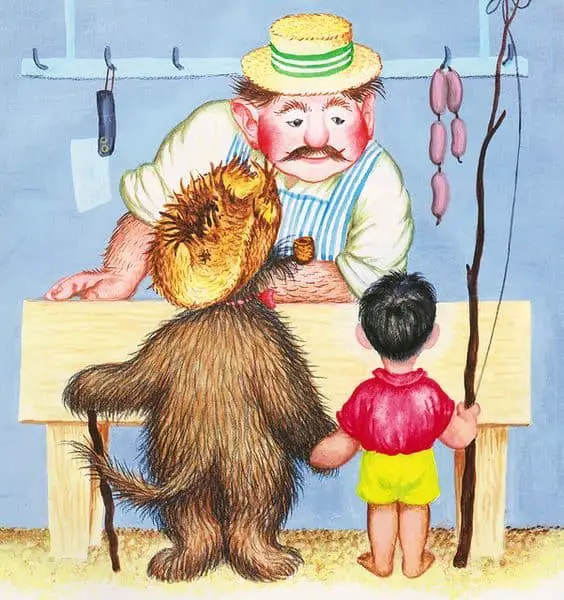
(But hey, have you ever seen such paltry wares at the butcher?)
ANAGNORISIS
Crispin’s Crispin was a conservative. He liked everything at the right time—
So begins the clean-up after the non-Battle. This is another unusual page to place near the end of a story, when the drama should be wrapping up. We’re still learning new things about Mister Dog when ordinarily, in a more classic story structure, Mister Dog has been through a near death experience and has learned something about himself.
In short, Margaret Wise Brown has continued to list things about Mister Dog for the reader as a proxy for the typical Anagnorisis.
This fits the story, in its own logical way. Mister Dog knows who he is and what he wants, and that is the entire point. That is the stand-out feature of his temperament.
NEW SITUATION
Dog and Boy go to bed. They’re happy because they each have control of their own dreams. This is a version of ‘And they both lived happily ever after’.
RESONANCE
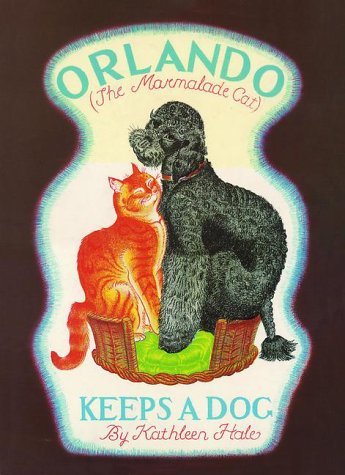
Contemporary children’s books starring anthropomorphised animals tend to steer clear of the uncomfortable reality that some kinds of animals (ie. humans) keep other animals as house slaves, or pets. Mister Dog and Orlando Keeps A Dog were both using this reality to laugh at the situation.
We now have plenty of children’s stories about being your own person (or animal) beholden to no one, believing in yourself. This was also a central message of Mister Dog. And I’ve no doubt Margaret Wise herself lived and died by that philosophy.
